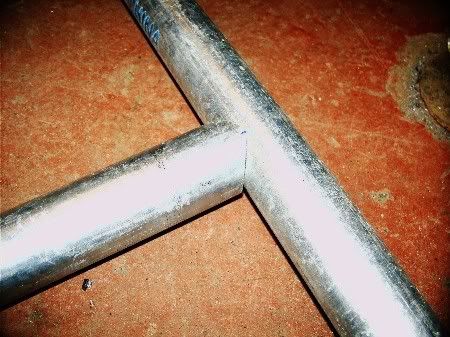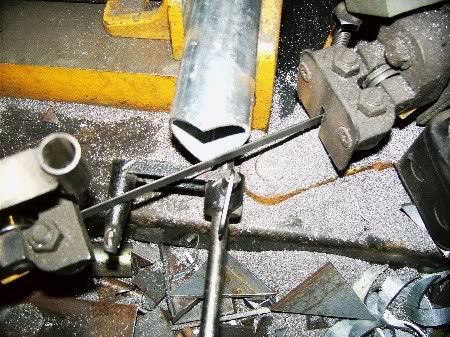Plain old saw does a very good job if you know how to use it.
With known tube size and joint angle, tube can be notched with great accuracy. The notch is achieved by cutting two opposing angles on one end of a piece of tube, to form a point. The cross-section of this cut will be an elliptical cut due to the shape of the tube. Changes in both of the two angled cuts must be made for the intersection angle and the size of the two tubes being joined. The only real limitation is the max angle of the chop saw.
You start with what I call the base angle. This is the angle of both cuts if the joint was 90[FONT="]°[/FONT]. For an example, I am fitting two tubes together that are both 1.75", at an 90[FONT="]°[/FONT] joint. The base angle or the angle of both cuts is 28[FONT="]°[/FONT]. These two cuts must meet at a point, and the point must also be centered on the tube.
What if I want a 15[FONT="]°[/FONT] joint with my 1.75" tube???? You must start with your base angle, witch was 28[FONT="]°[/FONT] for 1.75"(remember above), and subtract 15[FONT="]°[/FONT] from one cut, and add 15[FONT="]°[/FONT] to the other cut to form a perfect notch. So now I must make a 13[FONT="]°[/FONT] cut and an 43[FONT="]°[/FONT] cut , with the point centered on the tube. Perfect coped joint, with no grinding.
Remember your base angle will change with the tube being cut and the tube that you are fitting to.
Here are a few examples of base angles...
2.0" to 2.0" tube, base angle of 30 [FONT="]°[/FONT]
1.75" to 1.75" tube, base angle of 28[FONT="]°[/FONT]
1.5" to 1.5" tube, base angle of 26[FONT="]°[/FONT]
1.25" to 1.25" tube, base angle of 22.5[FONT="]°[/FONT]
1" to 1" tube, Base angle of 20[FONT="]°[/FONT]
Now to fit different size tubes together
1.75" to 2" tube, base angle of 25[FONT="]°[/FONT]
1.75" to 1.25" tube, base angle of 45[FONT="]°[/FONT]
1.25" to 1.75 tube, base angle of 20[FONT="]°[/FONT]
1" to 2" tube, base angle of 12[FONT="]°[/FONT]
Ed



